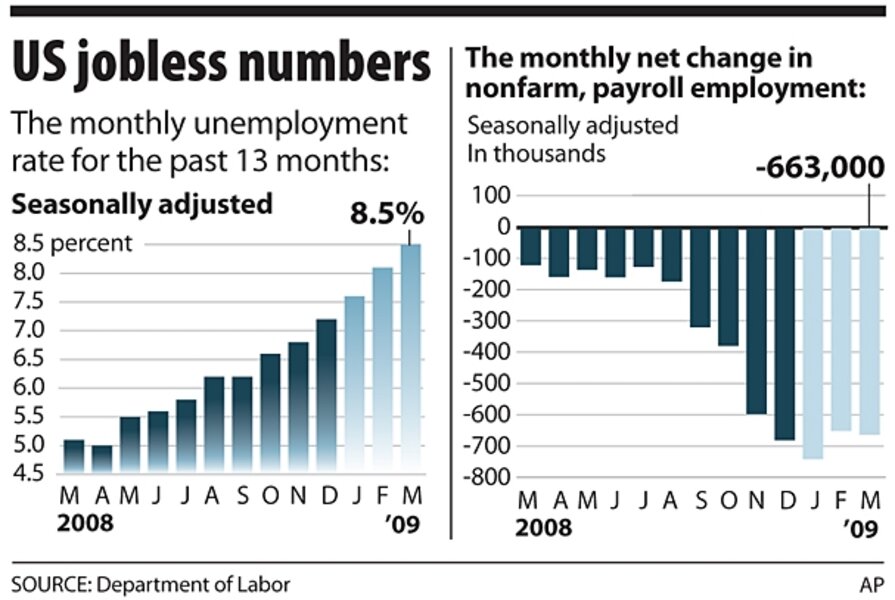Jobless rate hits 8.5 percent, a 26-year high
Loading...
| New York
In a normal March, businesses put out the “help wanted” signs to get ready for a more vigorous spring. But this time, many bosses were in survival mode and decided not to add to their payrolls.
As a result, America’s jobless rate in March hit 8.5 percent, the highest level since November 1983.
Overall however, businesses didn’t lay off as many workers last month as they did earlier in the year. That easing may be a sign that the recession is finally starting to bottom out, some economists say.
“The job losses are like a ski slope: They were steep at first, and now we are leveling off,” says David Wyss, chief economist at Standard & Poor’s in New York. “When we get down the bottom of the mountain, there may be a chair lift in the distant future.”
On a nonseasonally adjusted basis, only 58,000 jobs were lost last month, compared with the 172,000 that disappeared in February, according to the US Labor Department.
The government also releases adjusted figures, however. These take into account seasonal work and other normal hiring practices, which make one month comparable to the next. On this basis, the economy lost 663,000 jobs in March and 651,000 in February.
The economy has shed more than 2 million jobs in the first three months of the year, on the seasonally adjusted annual basis.
On the other hand, the Obama administration has projected that the economic stimulus package will create or save 3.5 million jobs, points out Dennis Jacobe, Washington-based chief economist at Gallup.
January was the worst month so far in 2009 for layoffs. On Friday, the government revised its estimate of that month’s job losses to 741,000, up from the original estimate of 655,000. Again, those were on a seasonally adjusted basis, which accounts for normal layoffs after the holiday season.
On a nonseasonally adjusted basis, the economy shed 3.6 million jobs in January alone.
“It’s an enormous number and a reflection of the announcements made before the holidays when pink slips were flying all over the place,” Mr. Wyss says.
Because the job cuts were so steep early in the year, some economists are hoping they will begin to slow down in the second quarter. “I don’t think we’ll be getting 2 million more job losses in the next three months,” says Joel Naroff of Naroff Economic Advisors in Holland, Pa.
In fact, on Wednesday, Challenger, Gray & Christmas, a Chicago outplacement firm, said the number of planned job cuts fell 19 percent to 150,411 in March. This was the second consecutive decline and the lowest number since last October.
However, the weekly report of new claims for unemployment insurance still has a figure in the 650,000 range, Mr. Naroff points out. “If this continues through April, we could see the unemployment rate hit 8.8 percent,” he predicts.
The rising unemployment rate can cause Americans to pull back on their spending, Mr. Jacobe says. “It’s something the average American pays attention to. It’s in the headlines,” he says.
Yet despite the rising unemployment rate, Gallup’s polls are finding some stability in consumer confidence, Jacobe says. “The numbers are low but stable. They are not continuing to decline,” he says. “The next couple of months we will know if the stimulus is helping.”
As part of the stimulus package, most Americans should start to see a small increase in their paychecks that reflects a reduction in the amount of money deducted for taxes. And some 55 million individuals who get Supplemental Security Income (SSI) or Social Security will get a check for $250 in late May.
“It should help with basic spending,” Jacobe says.
One sign of an economy bottoming out is when employers start to increase the weekly hours of their workers. In March, however, this didn’t happen. For the average employee, the weekly hours worked fell by 0.1 to 33.2 hours, the lowest number of hours since the Bureau of Labor Statistics started keeping track in 1964.
“An increase in weekly hours would be a signal the outlook is improving – but weekly hours fell today,” writes Nigel Gault of IHS Global Insight in an analysis of the news.
In fact, the March report shows that the number of Americans working part time on an involuntary basis climbed by 423,000 to 9 million.
Still, there is a hint of some improvement: The decline in hiring of temporary workers has eased, Mr. Gault notes. Businesses often hire temps before they start rehiring workers.
Last month 72,000 temp jobs were lost – an improvement over a peak loss of 90,000 in January.






